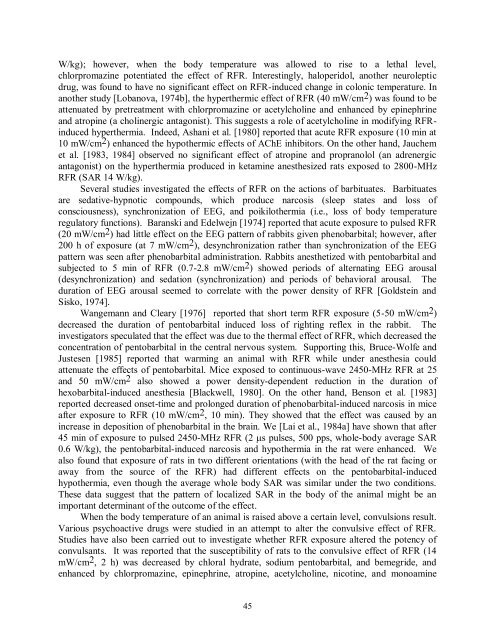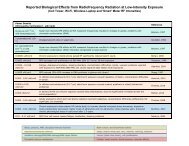Evidence for Effects on Neurology and Behavior - BioInitiative Report
Evidence for Effects on Neurology and Behavior - BioInitiative Report
Evidence for Effects on Neurology and Behavior - BioInitiative Report
Create successful ePaper yourself
Turn your PDF publications into a flip-book with our unique Google optimized e-Paper software.
W/kg); however, when the body temperature was allowed to rise to a lethal level,<br />
chlorpromazine potentiated the effect of RFR. Interestingly, haloperidol, another neuroleptic<br />
drug, was found to have no significant effect <strong>on</strong> RFR-induced change in col<strong>on</strong>ic temperature. In<br />
another study [Lobanova, 1974b], the hyperthermic effect of RFR (40 mW/cm 2 ) was found to be<br />
attenuated by pretreatment with chlorpromazine or acetylcholine <strong>and</strong> enhanced by epinephrine<br />
<strong>and</strong> atropine (a cholinergic antag<strong>on</strong>ist). This suggests a role of acetylcholine in modifying RFRinduced<br />
hyperthermia. Indeed, Ashani et al. [1980] reported that acute RFR exposure (10 min at<br />
10 mW/cm 2 ) enhanced the hypothermic effects of AChE inhibitors. On the other h<strong>and</strong>, Jauchem<br />
et al. [1983, 1984] observed no significant effect of atropine <strong>and</strong> propranolol (an adrenergic<br />
antag<strong>on</strong>ist) <strong>on</strong> the hyperthermia produced in ketamine anesthesized rats exposed to 2800-MHz<br />
RFR (SAR 14 W/kg).<br />
Several studies investigated the effects of RFR <strong>on</strong> the acti<strong>on</strong>s of barbituates. Barbituates<br />
are sedative-hypnotic compounds, which produce narcosis (sleep states <strong>and</strong> loss of<br />
c<strong>on</strong>sciousness), synchr<strong>on</strong>izati<strong>on</strong> of EEG, <strong>and</strong> poikilothermia (i.e., loss of body temperature<br />
regulatory functi<strong>on</strong>s). Baranski <strong>and</strong> Edelwejn [1974] reported that acute exposure to pulsed RFR<br />
(20 mW/cm 2 ) had little effect <strong>on</strong> the EEG pattern of rabbits given phenobarbital; however, after<br />
200 h of exposure (at 7 mW/cm 2 ), desynchr<strong>on</strong>izati<strong>on</strong> rather than synchr<strong>on</strong>izati<strong>on</strong> of the EEG<br />
pattern was seen after phenobarbital administrati<strong>on</strong>. Rabbits anesthetized with pentobarbital <strong>and</strong><br />
subjected to 5 min of RFR (0.7-2.8 mW/cm 2 ) showed periods of alternating EEG arousal<br />
(desynchr<strong>on</strong>izati<strong>on</strong>) <strong>and</strong> sedati<strong>on</strong> (synchr<strong>on</strong>izati<strong>on</strong>) <strong>and</strong> periods of behavioral arousal. The<br />
durati<strong>on</strong> of EEG arousal seemed to correlate with the power density of RFR [Goldstein <strong>and</strong><br />
Sisko, 1974].<br />
Wangemann <strong>and</strong> Cleary [1976] reported that short term RFR exposure (5-50 mW/cm 2 )<br />
decreased the durati<strong>on</strong> of pentobarbital induced loss of righting reflex in the rabbit. The<br />
investigators speculated that the effect was due to the thermal effect of RFR, which decreased the<br />
c<strong>on</strong>centrati<strong>on</strong> of pentobarbital in the central nervous system. Supporting this, Bruce-Wolfe <strong>and</strong><br />
Justesen [1985] reported that warming an animal with RFR while under anesthesia could<br />
attenuate the effects of pentobarbital. Mice exposed to c<strong>on</strong>tinuous-wave 2450-MHz RFR at 25<br />
<strong>and</strong> 50 mW/cm 2 also showed a power density-dependent reducti<strong>on</strong> in the durati<strong>on</strong> of<br />
hexobarbital-induced anesthesia [Blackwell, 1980]. On the other h<strong>and</strong>, Bens<strong>on</strong> et al. [1983]<br />
reported decreased <strong>on</strong>set-time <strong>and</strong> prol<strong>on</strong>ged durati<strong>on</strong> of phenobarbital-induced narcosis in mice<br />
after exposure to RFR (10 mW/cm 2 , 10 min). They showed that the effect was caused by an<br />
increase in depositi<strong>on</strong> of phenobarbital in the brain. We [Lai et al., 1984a] have shown that after<br />
45 min of exposure to pulsed 2450-MHz RFR (2 s pulses, 500 pps, whole-body average SAR<br />
0.6 W/kg), the pentobarbital-induced narcosis <strong>and</strong> hypothermia in the rat were enhanced. We<br />
also found that exposure of rats in two different orientati<strong>on</strong>s (with the head of the rat facing or<br />
away from the source of the RFR) had different effects <strong>on</strong> the pentobarbital-induced<br />
hypothermia, even though the average whole body SAR was similar under the two c<strong>on</strong>diti<strong>on</strong>s.<br />
These data suggest that the pattern of localized SAR in the body of the animal might be an<br />
important determinant of the outcome of the effect.<br />
When the body temperature of an animal is raised above a certain level, c<strong>on</strong>vulsi<strong>on</strong>s result.<br />
Various psychoactive drugs were studied in an attempt to alter the c<strong>on</strong>vulsive effect of RFR.<br />
Studies have also been carried out to investigate whether RFR exposure altered the potency of<br />
c<strong>on</strong>vulsants. It was reported that the susceptibility of rats to the c<strong>on</strong>vulsive effect of RFR (14<br />
mW/cm 2 , 2 h) was decreased by chloral hydrate, sodium pentobarbital, <strong>and</strong> bemegride, <strong>and</strong><br />
enhanced by chlorpromazine, epinephrine, atropine, acetylcholine, nicotine, <strong>and</strong> m<strong>on</strong>oamine<br />
45



